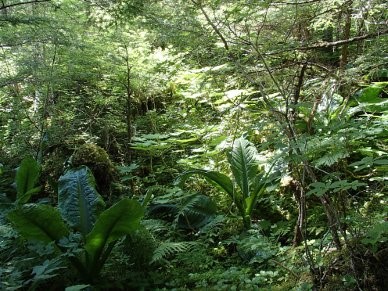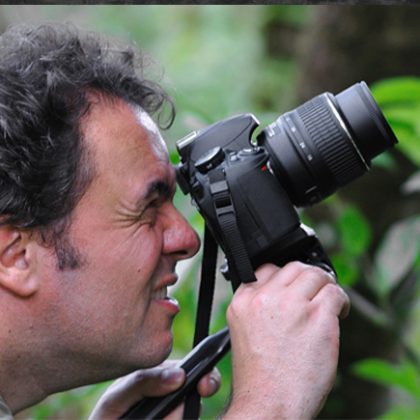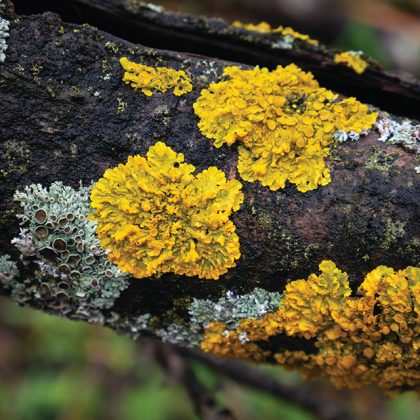Scratching the Iceberg – Undiscovered Lichen Diversity at Glacier Bay National Park
In this post we talk to Dr Alan M. Fryday and Dr Toby Spribille, Editors for The Lichenologist, about their Glacier Bay Special Issue which is available Open access.
This was a study of profound intensity and detail, to make an important point about undiscovered diversity; why did you choose Glacier Bay as the focal area for investigation?
Toby Spribille: Glacier Bay kind of chose us. We were fresh off a project with several of the same co-authors as on this paper in the nearby Klondike Gold Rush National Historical Park in 2010, and park biologists in Alaska talked amongst themselves as to what it would look like to undertake a comprehensive lichen survey in a more oceanic ecosystem closer to the outer Pacific coast. And this project was born.
Alan Fryday: I wasn’t involved with the Klondike project but had considerable experience with oceanic lichens from my time in Scotland. I was invited to participate in the Glacier Bay project after Tor Tønsberg dropped out because he “didn’t fancy camping with bears”. I wasn’t sure I fancied camping with bears either, but decided it was too good an opportunity to turn down. Tor, of course, soon regretted his decision and joined us anyway.

What were the particular challenges and rewards of working in this remote high latitude environment?
AF: Glacier Bay NP covers an area of over 10, 000 km2 and includes mountains more than 4500 m. high, but there are less than 5 miles of road and trails all centered around the Park Headquarters in Bartlett Cove. We were either bushwhacking through dense undergrowth or navigating extensive areas of muskeg (blanket bog). As an example, Excursion Ridge, the richest site we discovered, was only a 3.5 km hike and an altitude gain of c. 700 m, but it took 5 hours to access – and that was after we had been shown the ”easy” route, which still involved wading knee-deep through a fast-flowing river!
The rewards, however, were substantial! Apart from a regular flow of apparently new species of lichens, we had access to a vast area of wilderness with abundant wildlife – brown and black bears, moose, whales and orcas, sea otters, steller sea lions, crested and horned puffins, etc. – and the scenery…

TS: The biggest challenge with Glacier Bay National Park was always access. Many American national parks allow helicopter access to remote areas, but Glacier Bay is simultaneously a designated National Park and protected under two additional laws, the 1964 Wilderness Act and the 1980 Alaska National Interest Lands Conservation Act. Only modes of transportation that were in active use at the time the wilderness status came into effect could continue to be used after that date. This meant that for most of Glacier Bay, we were limited to boat access, which placed us in wild, remote areas with towering peaks, but always disembarking on foot at sea level.

Furthermore, we were dependent on Park Service boat captains and their schedules. So we had very little wiggle room to dictate our own terms or design randomized survey plans. Many of our surveys were overnight trips or short surveys within walking distance of a suitable landing spot, but in a few cases we were able to stay out extended periods and also bushwhack to the alpine treeline.

It is a study with thirteen international authors, can you comment on how important it was to build the right team?
TS: In the beginning there were five of us on the core team (the first five authors) who were the only ones to visit Glacier Bay, and we hoped that we could take care of our different areas of expertise in a place we already expected would be highly diverse. We were really happy that other experts were willing to join in and analyze data subsets as we realized the scope of expertise needed to handle newly discovered diversity. I think it really speaks to the extent to which a project like this has to be a hybrid between inventory and “on-the-wing systematics”. When you have a species which doesn’t seem to fit anything in the books, it is beyond helpful to be able to integrate it into a worldwide overview of all species in its genus. This is one thing we have tried to do in this project.
AF: It soon became obvious to us that we couldn’t do all the taxonomic work ourselves and that we needed assistance from experts in specialist groups. It is a great credit to the lichen community that everyone we contacted agreed to examine our collections, so the team more or less built itself.
The rate of undiscovered diversity is sobering; were you surprised, and how widespread do you think this knowledge gap is, for lichens?
AF: The variety of different habitats at Glacier Bay is staggering, Ranging from intertidal to high alpine and with coniferous and deciduous woodland, plus a vast array of different rock types from pure limestone through to granite. For me, getting above the tree line into the open alpine heath was a magical experience. We only managed it at two locations, but the diversity of the saxicolous lichen biota there was greater than anything I have previously experienced. Unfortunately, at both localities, access was so difficult that we only had 1-2 hours to collect, so it is almost certain that we sampled only a small percentage of the total diversity. Our sampling at Glacier Bay was also very much concentrated around the main bay, with only a few collecting locations along the southern coast. For logistic reasons, we were unable to visit the 150 km long Outer (Pacific) Coast, which experiences a different climate and would likely have yielded a different suite of lichen species. At one point we considered titling the paper “Scratching the Iceberg – Lichens of Glacier Bay NP” (combining the idioms ‘scratching the surface’ and ‘the tip of the iceberg’) because that was all it felt like we had achieved.
It is generally accepted by biologists that biodiversity is highest in the tropics and decreases with increasing latitude. For lichens, at least, that is an over-simplification because there are other, probably more important, factors involved – chiefly continental position, with oceanic areas probably having the greatest diversity. We would also argue that lichen biodiversity does not follow a smooth latitudinal gradient but has peaks in the tropics and the cool temperate zones. Glacier Bay is near the maximum for both these diversity curves, which would help explain the enormous diversity – but we really need more inventories of this type in other areas of the cool temperate to test these hypotheses.
TS: The northwest North American temperate and boreal rainforest ecosystem can really take your breath away with its lichen diversity, so in a way it was not surprising. Honestly, though, I suspect that the knowledge gap is still large in most places. It is not an exaggeration to say that it is still possible today for careful observers to go out into their backyard ecosystems and discover new species for science. And they should do it while those ecosystems still exist.
Glacier Bay is the latest episode in careers that have taken you across the globe to discover lichens; what’s next?
TS: I’ve sworn this would be the last project of its kind I’ll ever undertake, but as we speak I am already tempted to tackle the next one. I’d love to perform this kind of study in a cold, continental ecosystem and see what’s different. The conventional wisdom in academia is that biodiversity inventories are old-school and on their way out, and presumably we should all be pipetting our way into the Royal Society. But tactile biology is making a comeback, and we shouldn’t be shy. Looking at lichens in the field, and by that I mean the diversity of symbiont pairings and how the symbiosis “does it” in its native habitat, stimulates me to think about biological problems in a way lab work does not. I couldn’t imagine not doing it.
AF: I’m retired now but getting out into the field and discovering what was there was always my prime motivation. I did what I did because I loved it – building a career was never one of my priorities. I consider myself, extremely fortunate to have been able to visit so many places and achieve so much and will always be grateful to the many people who have given me those opportunities. Although I am still involved in other projects, the Glacier Bay project was, in many ways, the culmination of my work and I feel privileged and proud to have been part of it. We often felt overwhelmed by the enormity and complexity of this project and the thought of repeating it was unimaginable, but just looking at maps brings back all the old hunger and I would do it all again in a heartbeat!
Are you worried at all about the effects of climate change in Glacier Bay?
AF: Many of the glaciers at Glacier Bay have been in recession for decades and it is uncertain what affect global climate change is having on them. However, glaciers elsewhere in SE Alaska, including some that until recently have been stable, are recessing at an alarming rate, so it is likely that those at Glacier Bay will follow a similar pattern. Perhaps the more pressing concern for Glacier Bay is the pollution from cruise ships. The park has a love/hate relationship with the cruise industry. It is a major source of income for the park but the negative effects are, potentially, extremely damaging, both in terms of pollution and disruption to wildlife and habitats. It will be interesting to see what effects the current coronavirus situation will have.
TS: Yes and no. There are places in the world where ecosystems are on a knife edge, such as where increase in fires can push an ecosystem from being wooded to losing its forest, or where rare species at the tops of mountains will get pushed off into oblivion by warming temperatures, where a lot will change and it is very worrying. I suspect Glacier Bay will be buffered from “knife edge” changes by its proximity to the ocean and its tremendous landscape diversity, so it might take longer before it is life-and-death.
Read Dr Fryday’s and Dr Spribille’s Special Issue article, ‘Lichens and associated fungi from Glacier Bay National Park, Alaska‘, which is available Open Access.





